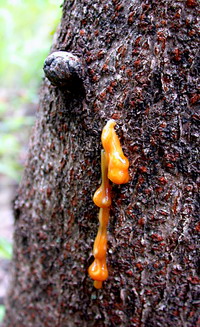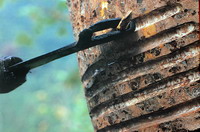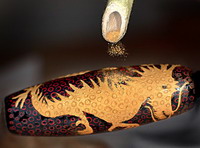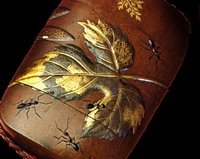DID YOU KNOW THAT...?
 |
...The Japanese name of The Far-Eastern lacquer is "URUSHI".
ABOUT ITS ORIGIN:
...Urushi is the sap of a tree and therefore “vegetable” in origin.
...Urushi is viscous in appearance and has a similar texture to honey.
...Urushi is obtained by the same method that is used for collecting gum from rubber tress.
...it takes 8-10 years for a lacquer tree to reach the point where it yields the maximum amount of urushi, which is only a few hundred grams of sap.
...after the harvest when trees have discharged their protective sap they die.
...the Japanese plant new saplings in the shade of older trees so that they can be harvested over a period of years without leaving the land to lie fallow.
 |
...the lacquer tree (Rhus Vernicifera) can only live in the Far East.
...the closest European relative to the Urushi-tree is the Poison Ivy.
...in Japan the best quality urushi is collected in springtime before sunrise, as it is photosensitive.
...the Japanese prepare the best quality lacquer in the world.
...to avoid exposure to dust the Japanese used to paint lacquer objects while they were far out at sea.
 |
...lacquer differs from enamel in that it sets in vapour rather than fire.
...Urushi needs to harden for 4-5 days at room temperature in a moisture-retentive and dust-proof cupboard (urushi-buro) until it is ready to be polished.
...you must polish each and every layer by hand, even though an object may have over 100 layer
...the smoothness of the lacquer surface rivals that of glass.
...the urushi harvested in springtime is transparent to such a degree that it allows the gold dust to sparkle through.
...silver, gold and even platinum dust is sprinkled into the lacquer layers. (maki-e)
...the fine precious metal dust is sprinkled onto the sticky surface of the lacquer by using different sized filters on bamboo tubes (funzutsu)
 |
...the valuable dust can be so fine that even a tiny breath blows it away.
...only a handful of Japanese families know the secret technique of shaping of the individual grains of the precious metal powder.
...objects appear to be made entirely of gold or silver even if they are only very thinly covered with this material.
...when you choose the colour of the object you have to take into account the fact that it will darken for the first two years and then gradually becomes lighter.
...you can achieve a deep black colour by using petrol soot.
...you can create any colour of lacquer by mixing different pigments with it, but white will become ivory and blue will appear as green.
 |
...rather than simply carving a piece of wood to create a relief texture, the Japanese choose to build up the surface of the motifs by using many layers of lacquer. (taka-makie)
ABOUT ITS SPECIAL QUALITIES:
...the carefully crafted urushi objects are resistant to even corrosive salty water.
...lacquer ware is also resistant to heat, and will not be marked by a burning cigarette.
...a mixture of lacquer and vermilion has been used to protect shrines from putrefiable articles for many centuries, and even to cover ancient coffins of mummies.
...vermilion is a derivative of burnt mercury and as such is an extremely toxic heavy metal.
 |
...Japanese used to protect the blade of their very highly prized samurai swords in a lacquer covered wooden scabbard.
...Japanese repaired very thin broken porcelain with urushi because of its strong adhesive qualities: even when used at high temperatures it forms strong and waterproof joints.
ABOUT ITS NAME:
...as porcelain from China is called “china” so lacquer from Japan is called ‘japonica’ in the English language.
...Japanese call lacquer urushi.
...in European languages you will find the syllable ‘lac’ (i.e. lacquer) when talking about urushi after the other shiny material from the Middle East called shellac with which they were already familiar as it arrived earlier to our continent.
 |
...shellac is a gum-like sediment of insects living in trees and is of animal origin.
ABOUT THE HISTORY OF LACQUER ART:
...the oldest evidence of urushi being used to decorate and protect dates back more than 9000 years in Japan.
...due to the extremely high value of the urushi-sap, in certain areas of medieval Japan it was used as a compulsory way to pay taxes.
...in medieval Japan it was a tradition for the majority of a wealthy lady’s dowry to be made up of lacquer ware.
...Japan and China contest as to who used the sap of the Lacquer-tree the earliest.
...the Portuguese and the Dutch imported the majority of the early lacquer ware to Europe.
 |
...the European varnish industry was inspired by Far Eastern lacquer ware from the 16th century.
...in Japan no household would be without at least one urushi object, even if it were only a simple pair of chopsticks.
...incredibly, in the whole of Europe less than forty artists work with urushi, despite the fact that among serious collectors there is a growing demand for high quality lacquer ware.